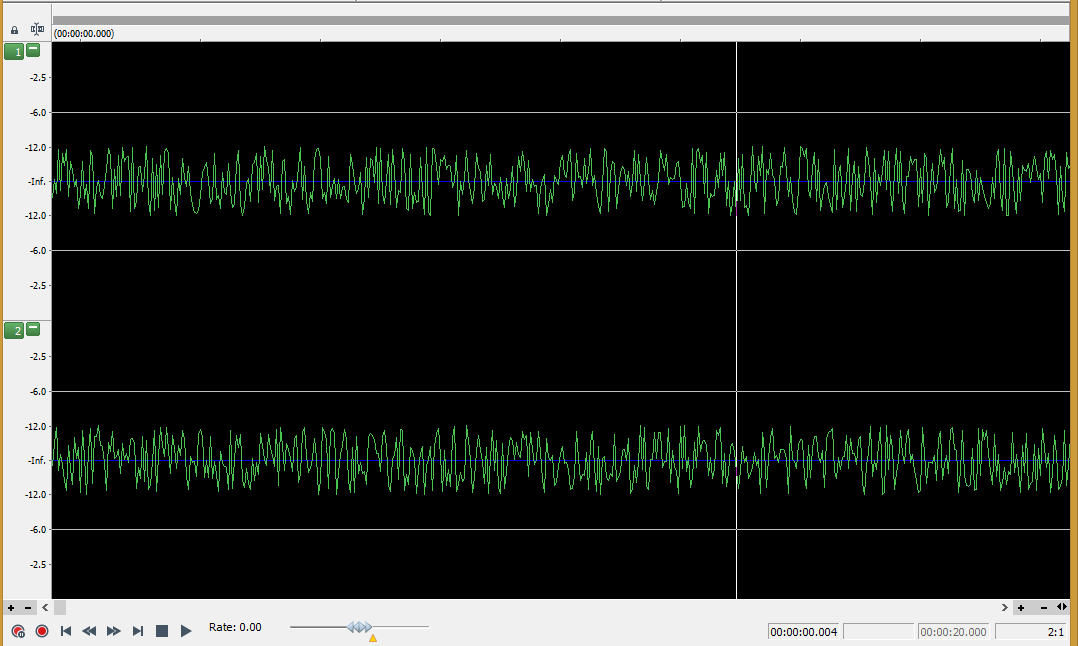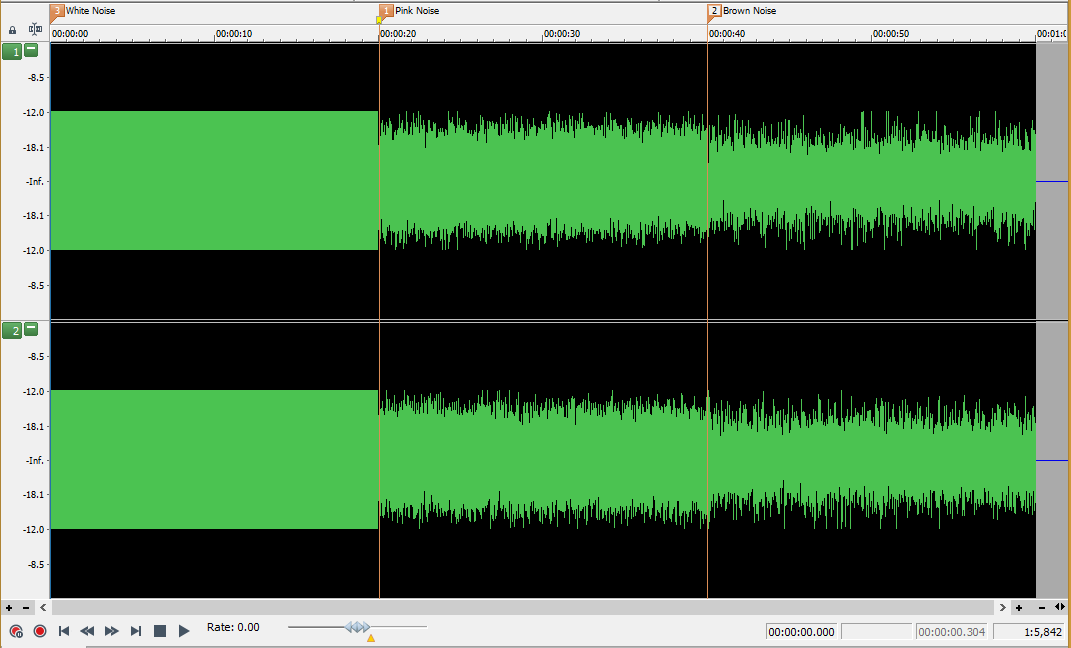But this is where the waveform amplitude can now be understood for what it is – the low frequencies have a very large amplitude because we can’t hear softer ones. Likewise the high frequencies are of a much lower amplitude. If we could hear both of these ranges equivalently, there wouldn’t be the large spikes for kick drums, the waveform would look like this:
That is a zoomed in picture of white noise – which is a “color” of noise that contains all audio frequencies equally – similar to white light, that contains all light frequencies equally.
Here we see three colors of noise – all generated at the same level (-12dBFS).
White noise, in the first third of the display, is quite dense, as all frequencies in the audio range are represented equally. This means that over the audio range of 20Hz to 20kHz, the top octave of hearing – 10kHz to 20kHz – has half of the total energy of the signal.
Hearing is logarithmic in nature, with each octave doubling in frequency.
For instance, the 40Hz range between 40 and 80Hz we perceive as an octave of pitch, the same as the 10,000Hz between 10kHz and 20kHz. The sounds that live up in that top octave are very bright and very soft in music we would typically listen to. This range contains the top end of cymbal crashes and the sizzle that older age hearing loss begins to effect.
As we saw above, low frequencies need to be loud in order to be heard in a balanced fashion, and white noise is pretty much the opposite of that.
How to get the colors
If you pass white light through a prism, a rainbow of colors results of frequencies of light sorted by wavelength. The red areas of that spectrum have longer wavelengths; therefore the filtering of the white noise to favor longer wavelengths is characterized as “Pink”.
The next third of the waveform above is Pink Noise. White noise passed through a 3dB per octave filter shapes the sound such that now each octave is represented with equal energy. In this case 40-80Hz range now matches the 10-20kHz range and all other octaves in amplitude.
Pink noise is useful to set up rooms with real time analyzers. A pink noise signal is amplified through the system and a very flat response microphone is used to feed the RTA, which shows a given level at generally third octaves of a given input. “Flattening” the system uses an appropriate equalizer to raise or lower each band until the readout is the same, or flat, across the full frequency range on the analyzer.
The last third in the image above is Red noise, also called Brown noise. This is white noise filtered at 6dB per octave and has much lower frequency distribution, and is often used in oceanography.
There is also Blue Noise – that takes white noise and adds a 3dB per octave boost. Blue noise is typically used for dithering in digital signal processing.
At the far other end of the spectrum, we have Black Noise – silence.
Speakers are like lights
While thinking about this article, I made an interesting connection. These light colors applied to sound also can be applied to thinking about our loudspeakers. Tweeters beam, woofers flood. It seems that qualitative differences between speaker systems could be similar to the differences of quality light sources. The best systems typically provide the best “lighting” of the sound.
This brings us back to the point at the top of the article – there are those who think that speakers made for the recording studio may give better results than those designed for the listening room.
The challenge with this is that studio speakers like the Yamaha NS-10s which are ubiquitous in the studio can be considered harsh overhead florescent lights, used in workshops to ensure there are no unseen flaws that show up on poor systems.
Just like fine food or fine art, the set and setting of its presentation is a large part of the artist’s intent. Instead of wanting to see and hear the process of the dinner being made, we may just want to light it with our systems – and make it pretty.
Even Studio Monitors are not always Studio Monitors
I use a set of JBL 4208s as my mastering monitors. I have had these since 1992, and know them intimately. I had cycled through a number of subwoofers in the system, and with some reports from clients about bass response in their masters, I decided to “upgrade” my monitors in 2008.
I’ve been a big proponent of flattening the room at the listening position. With accurate EQ set appropriately using an RTA for the system the difference between the flattened curve and bypass for the speakers is night and day.
The JBL 4300 series had just been released, and these systems had an RTA and DSP integrated into their powered loudspeakers, so I was happy to take the plunge and change my monitoring. I bought the system of LSR4326P monitors and the LSR4312SP subwoofer. The sub was great, but several challenges arose with the complete system.
First of all, my trusted JBL 4208s have a titanium dome tweeter, which provides a very crisp and accurate reproduction of the articulation area of the frequency range – the upper midrange. I didn’t realize how much I relied upon this accuracy in my mastering practice.
The 4208s were retired to the basement and I set up the new system. Flattening the response using the supplied software and reference microphone, I looked forward to the results I had heard at the NAMM show that year.
It turned out that the software to “flatten” the system actually only seemed to put a notch in the bass at a single frequency. When I manually flatten a system, I painstakingly cover the entire frequency range, so this was a bit of a letdown for me. Then, I started to master a few of my own projects in order to get used to the new system.
Pulling up a file and going to work on it, I was very concerned that I had lost part of my hearing. The upper midrange crispness was totally missing. I had to guess at what was the right balance. This was a big concern.
It turns out that the silk dome tweeter was deficient in this frequency range (or that the titanium dome tweeter I had been used to was hyper sensitive). I bypassed the internal DSP and set about flattening the new system by hand, but no matter how much energy I gave to that frequency range, there was no ability to recover the fidelity that I had come to rely on for my work.
This resulted in the 4208s coming back up into the studio and the 4326s to be disconnected. I have been very satisfied with the 4312 subwoofer however, and use it to this day.
Just like in audiophile systems, studio systems have a broad variety of responses, and provide different tool sets depending on their desired uses. To encourage using one type of system over another is indefensible — the appropriateness to task of a given system has to be known and tested. Like music itself, each note should be in time, tone and tune for the situation at hand.
Part of the joy of loving audio is to find that appropriate system, and once found, use it for the task — music and audio appreciation.
- ← Previous page
- (Page 2 of 2)



It’s a bit off topic. The title of the article got my attention. As a young person to about fifteen, I heard colors in music. While being in a band, the colors added to the excitement of playing in a band. As a listener, I enjoyed the extra information. In the present, a few times for moments colors reappear between the speakers. It’s rare though. This hearing color business is a slice of synesthesia.